Sports
Brisbane takeaways


No.1 seed Aryna Sabalenka survived a stern test from No.15 seed Yulia Putintseva in the Brisbane International third round, coming from 5-3 down in the first set to win 7-6(2), 6-4 in 1 hour and 49 minutes.Sabalenka, the 2024 runner-up to Elena Rybakina, was two points from losing the opener on four occasions but held her nerve in the most important moments to improve to 2-1 overall against Putintseva. Here are the key takeaways from the World No.1’s straight-sets victory:
‘Fabulous point!’ Putintseva’s spectacular defense foils Sabalenka
In the quarterfinals, the World No.1 will face another player who has provided a stiff challenge in the past — Marie Bouzkova, who upset No.10 seed and two-time former champion Victoria Azarenka 6-4, 6-4. That result was Bouzkova’s second Top 20 win of the week following her second-round upset of No.5 seed Jelena Ostapenko.
But whenever Sabalenka was in danger of facing a set point, she managed to keep the rallies short with accurate power of her own. Though she was unable to convert her first set point at 6-5, the three-time major champion dominated the ensuing tiebreak and carried her momentum into the second set, breaking Putintseva immediately with a bruising forehand winner.
Sabalenka’s path in Brisbane doesn’t get any easier
Should Sabalenka take revenge on Bouzkova, she will face either Andreeva or former World No.2 Ons Jabeur in the semifinals — two more players who can disrupt her power with their variety. Andreeva upset Sabalenka 6-7(5), 6-4, 6-4 in last year’s Roland Garros quarterfinals, while Jabeur has won two of their six meetings to date.
Putintseva has historically been a tough matchup for Sabalenka — the Kazakhstani won their first encounter at the 2019 US Open, then led 6-1, 4-3 in last year’s Wuhan third round before Sabalenka turned that match around. This proved the case again in Brisbane. Putintseva’s court awareness, variety and speed prevented Sabalenka from settling into a groove. The World No.29 peaked with a phenomenal defensive point, finding every line at full stretch, as she built a 5-3 lead.
A clutch first set proved decisive“I got an invitation from her for her birthday celebration next Friday,” Sabalenka said to the press. “After the match she said, ‘You’re not coming to my birthday!’ I said, ‘I’ll make sure I’ll bring you a good gift, so you’ll be OK with me.'”
Sabalenka and Bouzkova are tied at one win apiece, with the Czech winning their last match 6-4, 3-6, 6-3 in last July’s Washington semifinals.
Sports
No. 3 Volleyball Opens NCAA Tournament Versus Campbell – Texas A&M Athletics
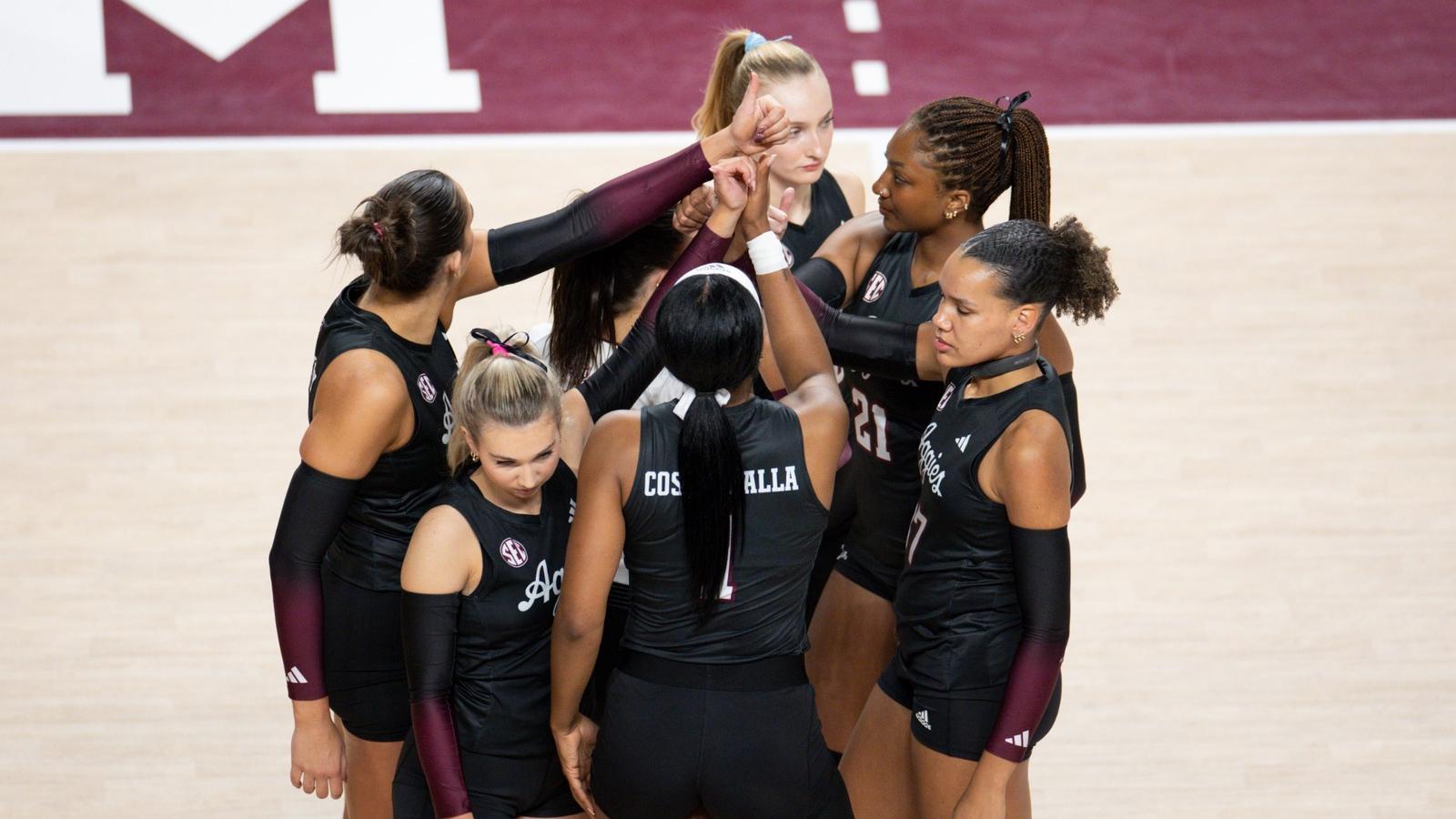
The Aggies ensured their third-straight tournament berth under the leadership of head coach Jamie Morrison, concluding the regular season and SEC Tournament with a 23-4 record. Their performance throughout the year earned them the highest AVCA ranking in program history of No. 6 and their first NCAA Tournament hosting opportunity since 2019.
Shining at home this season, the Maroon & White boast a 9-1 ledger at Reed Arena with its lone loss coming against then-No. 3 Kentucky (3-1). The 12th Man has been a force all year, as they helped break the program attendance record standing 9,801 strong versus Texas as well as accounting for another five top 10 attendances during the 2025 campaign.
Texas A&M’s depth of talent has been evident throughout the year and was rewarded during the SEC’s postseason honors, as a conference-high four Aggies were named to the All-SEC First Team including Logan Lednicky, Ifenna Cos-Okpalla, Maddie Waak and Kyndal Stowers. The honors didn’t stop there as Lednicky was named an AVCA Player of the Year Semifinalist, while the group accounted for 24 total accolades throughout the season.
The Matchups
Texas A&M enters its third NCAA Tournament with coach Morrison at the helm of the program, coming off a sweet 16 run during the 2024 season. The Maroon & White played the role of the hunter last season, downing No. 3 seed Arizona State in on their home court in the second round and came up just short in a five-set thriller against No. 2 seed Wisconsin.
The Aggies earned their highest seed since 2015 at No. 3 and welcome Campbell, TCU and SFA to Aggieland. They open their campaign versus the Camels who hold a 23-6 ledger and earned their second ever NCAA Tournament bid after winning the CAA Championship title in a five-set battle with Hofstra.
Friday’s meeting will be the first all-time between Texas A&M and Campbell. The Camels hold a strong 8-3 record when playing on the road but will come against the 12th Man and the Maroon & White’s 9-1 ledger in Reed Arena. On the stat sheet the Aggies hold the advantage in five of the seven team statical categories leading Campbell in kills per set, assists per set, hitting percentage, opponent hitting percentage and blocks per set, while the Camels have the upper hand in aces per set and digs per set.
Tracks and Trends
Logan Lednicky sits nine kills away from climbing to fourth in career kills at Texas A&M, she would pass three-time Olympian Stacy Sykora who has 1,586 kills.
Ifenna Cos-Okpalla has 159 blocks on the year and is three away from breaking her single season best of 161 and six from recording the most in a season since 1999 (165).
Streaming & Stats
Fans can watch the match on the ESPN+ and follow stats on 12thman.com.
Tickets
Fans can purchase their tickets to the opening round matches through 12thman.com/ncaatickets.
Students will be granted free admission to tomorrow’s game if they show their student ID’s at the north entry of Reed Arena.
Parking
Make plans to arrive early and exhibit patience for the expected traffic and parking congestion around Reed Arena. Multiple parking options are available for fans:
- General parking is available around the arena on gameday for $5 – cash AND card payments accepted.
- Fans with a valid TAMU parking pass can park for FREE in lots surrounding the arena. Make sure to have your pass barcode ready to show the lot attendant.
Follow the Aggies
Visit 12thMan.com for more information on Texas A&M volleyball. Fans can keep up to date with the A&M volleyball team on Facebook, Instagram and on Twitter by following @AggieVolleyball.
Sports
Volleyball Recaps – December 4
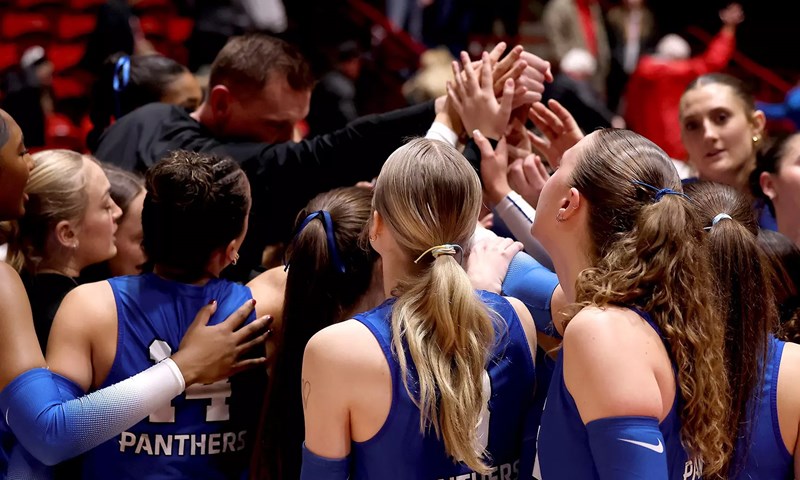
@#3 Wisconsin 3, Eastern Illinois 0
#3 WISCONSIN 3, EASTERN ILLINOIS 0
EIU dropped both sets one and two, struggling to find a rhythm early on. The Panthers trailed early in both of the first two sets right out of the gate and were unable to provide resistance. In set one, the Badgers hit 0.48% and 0.542% in set two. For the match, Wisconsin hit 0.435. EIU struggled connecting offensively, hitting 0% in set one and 0.022 overall. After the first two sets concluded, the Panthers looked for a spark, and Tori Mohesky answered the call with fireworks right from the jump. Mohesky earned a service ace to calm the Badgers crowd. EIU returned back-to-back points to hold their largest lead, fueled by Destiny Walker and a Wisconsin attack error. Shortly after, EIU trailed 15-9 heading into the media timeout. After the break in the action, both teams went back and forth trading points. Wisconsin reached set point 24-15. However, the Panthers found life and roared back into the match, scoring four straight unanswered points charged by a Katie Kopshever service ace and two blocks by Emma Schroeder and Sylvia Hasz. Unfortunately, the Badgers closed out the set 25-19.
By The Numbers: EIU records their third NCAA Tournament appearance in program history. Destiny Walker led the way offensively with 6 kills and 1 service ace. Sylvia Hasz collected 16 assists and 3 block assists. Defensively, Ariadne Pereles recorded 8 digs, while Emma Schroeder produced 5 block assists. Lilli Amettis and Katie Kopshever each collected a block assist.
The Panthers’ historic season comes to a close, finishing with a 24-8 (15-3 OVC) record. After being picked to finish 8th in the OVC preseason poll, EIU stormed through conference play, securing their second OVC title in three years. EIU also collected their fourth regular season title in the program’s history. The Panthers made their third NCAA Tournament appearance.
Sports
Women’s Volleyball Opens NCAA Tournament Against USF on Friday – Penn State
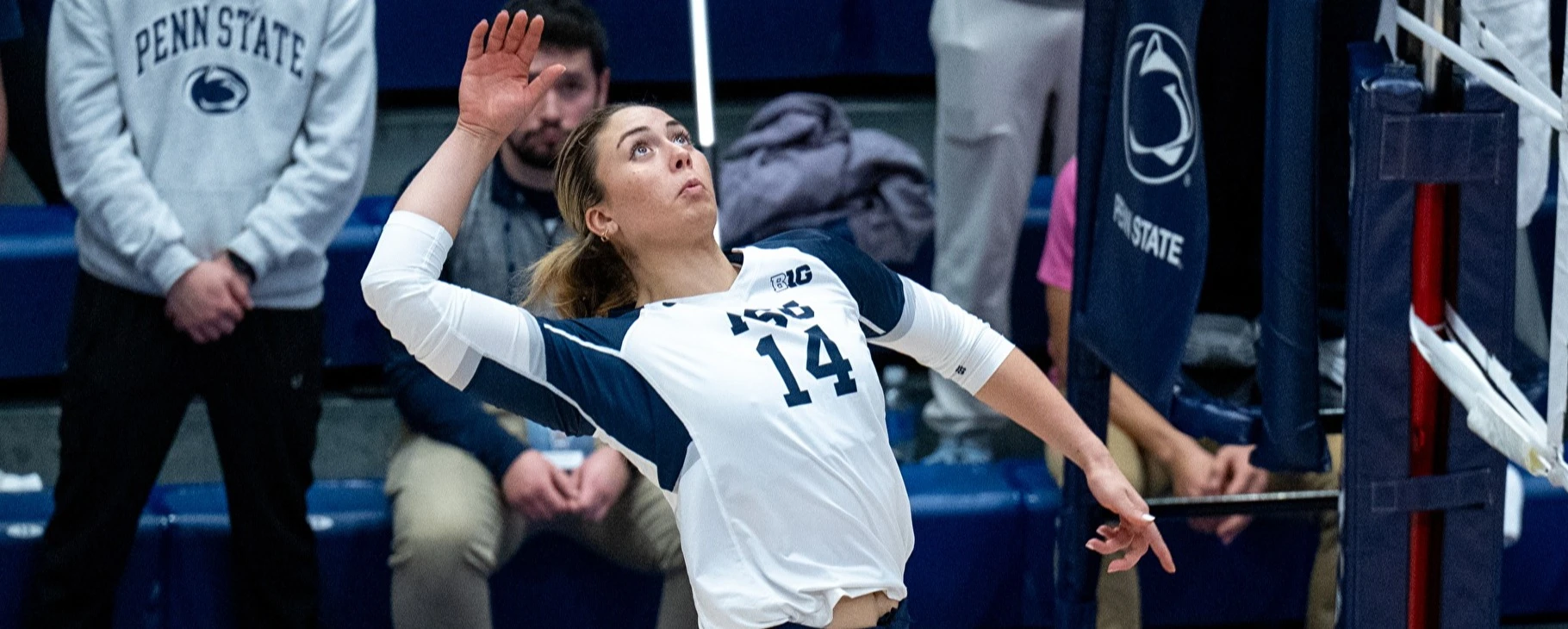
UNIVERSITY PARK, Pa.- No. 25 Penn State opens its 45th-straight appearance in the NCAA Tournament with a first-round match against USF on Friday at Texas’s Gregory Gymnasium. The match is scheduled for 5:30 p.m. ET and will stream on ESPN+.
The winner of Friday’s match advances to play the winner between Texas and Florida A&M in the second round on Saturday.
HOW TO FOLLOW
Friday, Dec. 5 | 5:30 p.m. ET
No. 25 Penn State (18-12, 12-8 B1G) vs. USF (17-12, 12-4 AAC) | Live Stats | ESPN+
OPENING NOTES
• Penn State is set to open its 45th appearance in the NCAA Tournament. It is the only program in the country to play in all 45 NCAA Division I Women’s Volleyball Tournaments since the inaugural event in 1981.
• The Nittany Lions received an eight seed in the Austin Region and will play the first and second rounds away from Rec Hall for just the first time since the tournament was expenaded to 64 teams in 1998.
• Friday marks Penn State’s fourth NCAA Tournament appearance and 13th postseason match under Katie Schumacher-Cawley, who is in her fourth season as Penn State head coach. They are 10-2 in the NCAA Tournament under Schumacher-Cawley after going 6-0 and winning the program’s eighth national title last season.
• The Nittany Lions made it to at least the NCAA Regional Semifinal in each of Schumacher-Cawley’s first three seasons as head coach.
NCAA TOURNAMENT HISTORY
• Penn State, which has won eight national titles, including the most recent in 2024, is 116-35 all-time in the NCAA Tournament.
• Penn State has made the National Semifinals 14 times and the National Championship match 11 times.
• USF and Penn State will meet for the first time in the NCAA Tournament, making the Bulls the 76th different postseason opponent for the Nittany Lions. Just eight of those teams have a winning record against Penn State in the NCAA Tournament.
PENN STATE IN ROUND OF 64
• Penn State is 26-0 in the NCAA Tournament round of 64 since the event expanded to 64 teams in 1998.
• The Lions are 78-3 in sets played during that stretch, dropping one set to Howard in 2017, one to Towson in 2021, and one to Yale last season.
• Rec Hall was the venue for 24 of the 26 matches.
• Penn State is 3-0 in the Round of 64 under Schumacher-Cawley, beating UMBC in 2022, Yale in 2023, and Delaware State in 2024.
HOW THEY GOT HERE – PENN STATE
• Penn State earned an at-large bid to the NCAA Tournament after going 18-12 overall and 12-8 in the Big Ten.
• The Nittany Lions are one of 14 teams in the nation with four wins over teams ranked in the top 25 of RPI, beating No. 6 Creighton, No. 11 Wisconsin, No. 13 USC, and No. 15 Kansas.
• The Nittany Lions helped secure their spot in the NCAA Tournament with four wins in their final five matches, beating Ohio State (3-2), Michigan State (3-0), Maryland (3-0), and Iowa (3-1).
HOW THEY GOT HERE – USF
• USF received an at-large bid to the NCAA Tournament after going 17-12 overall and 12-4 in the American Conference on its way to a second-place finish in the conference standings. The Bulls lost to Tulsa in the semifinal round of the American Conference Tournament.
• The Bulls will play in the NCAA Tournament for the first time since 2002. They beat Florida State in the first round that year before falling to Florida in the second round.
• USF’s highest RPI win came in conference play with a sweep over No. 36 Tulsa. The highest non-conference RPI win came in five sets over No. 47 Dayton. They also pushed Purdue to five sets before losing in their season opener.
• Senior outside hitter Maria Clara Andrade was named the American Conference Player of the Year for the second-straight season. She was joined on the all-conference team by sophomore setter Raegan Richardson (first team) and junior outside hitter Laila Ivey (second team).
SERIES HISTORY – USF
• Penn State is 3-0 in the all-time series with USF. The teams first played in 1986.
• The Nittany Lions swept all three matches, winning 3-0 in 1986, 1988, and 2015. All three matches were played in Tampa.
• Penn State and USF have never met in the NCAA Tournament.
• Kennedy Martin is the only player on the Penn State roster that has played against USF. She hit .449 with 27 kills, six blocks, and two aces in Florida’s 3-2 win over the Bulls in 2023.
PENN STATE VS. AMERICAN CONFERENCE
• Penn State is 32-4 all-time against current members of American Conference.
• The Nittany Lions have played eight of the 13 teams in the conference and have a winning record against all eight. They are unbeaten against UAB (1-0), Charlotte (1-0), East Caroline (3-0), Memphis (2-0), Rice (3-0), South Florida (3-0), and Wichita State (1-0).
TOURNAMENT EXPERIENCE
• Eight Penn State players have combined for 50 matches of NCAA Tournament experience.
• Penn State head coach Katie Schumacher-Cawley (1999) and assistant coach Megan Hodge Easy (2007, 2008, 2009) combined for four national titles as players at Penn State.
Catherine Burke – 1 match
Ava Falduto – 6 matches
Gillian Grimes – 12 matches
Jordan Hopp – 6 matches (2 Iowa State, 4 Penn State)
Caroline Jurevicius – 6 matches
Kennedy Martin – 5 matches (5 Florida)
Maggie Mendelson – 8 matches (2 Nebraska, 6 Penn State)
Jocelyn Nathan – 6 matches
The 2025 Penn State women’s volleyball season is presented by Musselman’s.
Sports
Toledo Falls in First Round of NCAA Tournament to Indiana, 3-0
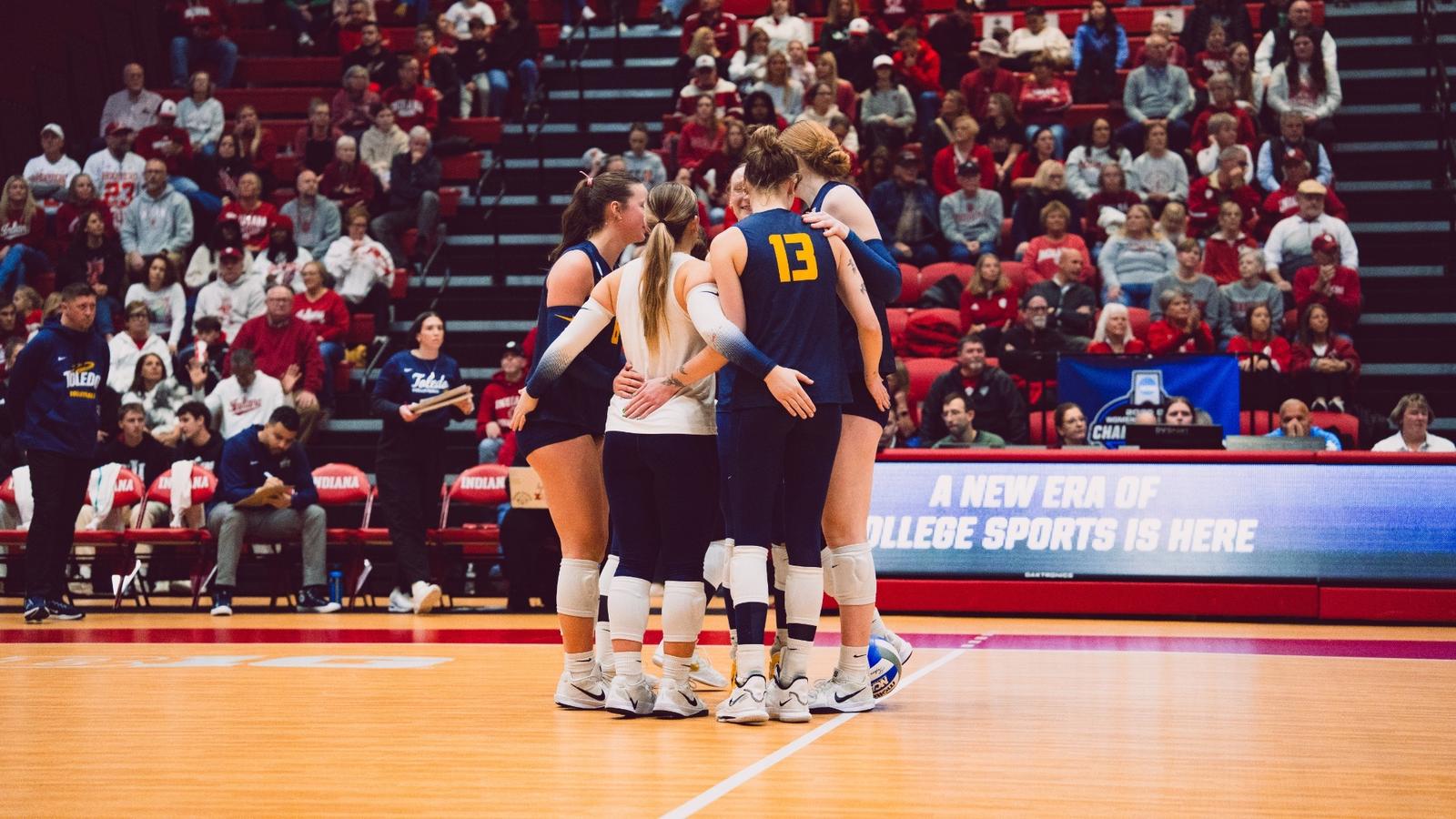
The Rockets finish the season with a 23-11 record, posting the second-most wins in program history .(1983 – 27 matches)
Sophomore Olivia Heitkamp led the Toledo offense with 11 kills, including five in the first set, for her 19th match this season in double-figures. Redshirt junior Sophie Catalano poured in seven terminations while redshirt sophomore Sierra Pertzborn chipped in six kills of her own.
Senior setter Kelsey Smith tallied 26 assists and a team-high nine digs. Sophomore Grace Freiberger and senior Macy Medors each totaled six digs.
Quoting Head Coach Brian Wright
“We’ve had a pretty special season in the past 11-and-a-half months that I’ve been at Toledo. I am so proud of this team and how they played tonight’s match. This team accomplished many great things this season, from leading the MAC in attendance, to winning their first MAC Tournament championship and playing in their first NCAA Tournament match. I want the team to understand that they are enough and capable to compete with the best teams and programs in this country.”
Senior Anna Alford
(on the 2025 season)
“This group has made Toledo history and it’s been such a great season. We’ve been working so hard for the past 11-and-a-half months and we just wanted a chance to showcase our abilities on the court and the love that this team has for one another.”
Senior Macy Medors
(on the future of the Toledo volleyball program)
“Our program is built on being a family and there is a great atmosphere amongst everyone involved. The younger players will continue that tradition and help Toledo volleyball continue to grow to new heights.”
Key Moments
- Olivia Heitkamp started the match with a kill as the Rockets and Hoosiers traded points early in the first set. Heitkamp’s fifth kill of the set kept it even, 11-11, before two quick points from Indiana gave the Hoosiers a 15-12 lead at the media timeout. A block from Anna Alford and Heitkamp kept UT within four, 22-18, but a quick 3-0 run for the Hoosiers gave them the set win.
- Both sides went back-and-forth to begin the second set before Indiana jumped out to a 7-4 lead. A solo block from Jessica Costlow sent the Rockets on a 3-0 run to even the frame, 9-9. The Hoosiers responded with an 8-2 run of their own to take a seven-point advantage, 19-12. Kills from Heitkamp and Sophie Catalano put UT within five, 19-14, but Indiana took the set win with four-straight points.
- Catalano fired off a kill to give Toledo a lead in the third set, 4-3. A quick 3-0 surge by the Rockets, highlighted by a kill from Sierra Pertzborn and Catalano, kept Toledo ahead, 7-5. Two service aces and two kills from the Hoosiers put IU in front, 12-9, before Heitkamp and Catalano each buried terminations to even the frame, 13-13. Indiana went on a 3-0 run to retake the lead, 17-14. Catalano and Pertzborn combined for a second block to stay within three, 19-16, but the Hoosiers ended the match on a 6-1 run to take the win.
Follow the Rockets
Instagram: Toledo_VB
Twitter/X: Toledo_VB
Facebook: Toledo Volleyball
Sports
Volleyball sweeps Fairmont State in first round of Atlantic Regionals
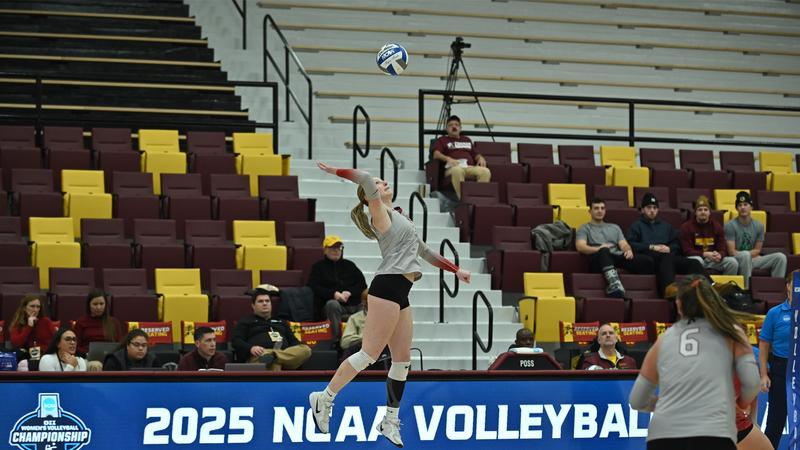
ERIE, Pa. – Indiana (PA) swept Fairmont St. 25-22, 25-19, 25-20 on Thursday at Highmark Events Center in Erie, Pa., in a neutral non-conference matchup.
Indiana (PA) was led by Charlotte Potvin, who posted 13 kills on a team-high .455 hitting percentage, adding four aces and 17.5 points in the three-set win. Delaney Concannon contributed 16 kills with 22 digs, while setter Ellie Rauch dished 45 assists and recorded two service aces.
Jessica Neiman added 14 kills on .464 hitting, while libero Lexi McLanahan finished with 15 digs. Rylee Brown anchored the front row with one solo block and two block assists, totaling three blocks and 2.0 points.
Indiana (PA) hit .268 for the match with 49 kills and 59 digs.
Fairmont St. saw 33 kills from a balanced attack and 49 digs defensively. Outside hitter Joey Borelle recorded 13 kills and seven digs, while Josie Nobbe totaled 11 digs and four kills. Chloe McDaniel added eight kills and four block assists.
The match featured 14 ties and nine lead changes in the opening set before Indiana pulled away late, scoring two straight points from the service line to close it out.
Indiana (PA) improved to 21-8 on the season, while Fairmont St. fell to 23-11.
Sports
Kentucky volleyball tops Wofford in Lexington NCAA tournament bracket
Updated Dec. 4, 2025, 11:27 p.m. ET

- Top-seeded Kentucky volleyball defeated Wofford in three sets to advance in the NCAA Tournament.
- Brooklyn DeLeye led Kentucky with 14 kills during the first-round victory.
- Kentucky will now face No. 8 seed UCLA for a spot in the Sweet 16.
LEXINGTON — Top-seeded Kentucky volleyball defeated Wofford in three sets Thursday night at Historic Memorial Coliseum to advance to the second round of the NCAA Tournament.
Brooklyn DeLeye led the Wildcats with 14 kills.
“This team especially, our depth, is so strong, and I think that just helps in practice,” DeLeye said after the match. “We’re pushing one another. No spot is guaranteed, and I think that’s truly helped us get to this No. 1 seed.”
UK will battle No. 8 seed UCLA Friday at 7 p.m. for a spot in the Sweet 16. UCLA defeated Georgia Tech in five sets Thursday night. A familiar face in former Louisville and current UCLA middle blocker Phekran Kong will sit across the net.
The ability to play in their home gym is huge for the Wildcats, coach Craig Skinner said.
“There’s a lot of really good teams, and every night out you got to be ready. You got to be ready for an enormous amount of challenges. And for us to be able to do that on our home floor is significant, and definitely we aren’t going to take that for granted.”
Kentucky takes a 23-match win streak into the second round after going undefeated in SEC play en route to the No. 2 overall seed. UK won the 2020 national championship, the first in program history.
Coverage during the match:
The Wildcats recorded 66 digs in three sets against the Terriers, led by junior libero Molly Tuozzo (19).
“I think it just all comes down to scouting and preparation,” Tuozzo said after the match. “I think we watched their hitters a lot beforehand, so we knew kind of their hard shots and what they like to do.”
UK completes its 15th sweep of 2025, besting Wofford in three sets (25-11, 25-19, 25-12). The Wildcats will face the No. 8 seed UCLA Bruins tomorrow night at Historic Memorial Coliseum. First serve is scheduled for 7 p.m.
UK is moments away from advancing to the second round of the NCAA Tournament. Brooklyn DeLeye leads all players with 13.5 points and 12 kills.
The Wildcats are one set away from their 15th sweep of the season and advancing to the second round of the NCAA Tournament. UK ended that frame on a 5-0 scoring run. Brooklyn DeLeye leads all players with nine kills.
The Wildcats regain the lead, marking the fourth time advantage has changed hands in this set. There have been 13 ties.
The Terriers lead with 11 kills.
UK takes the first set in a true team effort. Eva Hudson led the Wildcats with five kills, but five different Kentucky players notched at least one in the opening frame: Brooklyn DeLeye and Lizzie Carr have three each; Brooke Bultema has two; and Asia Thigpen has one. Kentucky ended the first set on a 4-0 scoring run.
The Wildcats lead early. Four UK players have kills already: Brooklyn DeLeye (2), Eva Hudson (2), Brooke Bultema (1) and Lizzie Carr (1).
Tonight’s match between No. 1 seed Kentucky and Wofford will begin 30 minutes after the conclusion of a 4:30 p.m. first-round match between Georgia Tech and No. 8 seed UCLA at Historic Memorial Coliseum.
Buy Kentucky volleyball tickets here
The match between the Wildcats and the Terriers will not air on a traditional TV channel.
It’ll be on ESPN+, which is available exclusively via livestream. Click here to subscribe.
UK will play No. 8 seed UCLA at 7 p.m. Friday. Here’s a look at the tournament schedule:
- First and second rounds: Dec. 4-6
- Regionals: Dec. 11-14
- Semifinals: Dec. 18 at T-Mobile Center in Kansas City, Missouri
- Championship: Dec. 21 at T-Mobile Center in Kansas City, Missouri
Click here to view the complete bracket.
- Aug. 23: Kentucky 4, Ohio State 0 (exhibition)
- Aug. 30: Kentucky 3, Lipscomb 0
- Aug. 31: Nebraska 3, Kentucky 2
- Sept. 5: Kentucky 3, Penn State 0
- Sept. 6: Kentucky 3, New Hampshire 0
- Sept. 10: Pitt 3, Kentucky 0
- Sept. 13: Kentucky 3, SMU 1
- Sept. 14: Kentucky 3, Houston 0
- Sept. 18: Kentucky 3, Louisville 2
- Sept. 20: Kentucky 3, Washington 0
- Sept. 24: Kentucky 3, South Carolina 0
- Sept. 26: Kentucky 3, Georgia 0
- Oct. 3: Kentucky 3, Ole Miss 0
- Oct. 8: Kentucky 3, Texas A&M 1
- Oct. 12: Kentucky 3, LSU 0
- Oct, 15: Kentucky 3, Auburn 0
- Oct. 19: Kentucky 3, Florida 2
- Oct. 24: Kentucky 3, Mississippi State 1
- Oct. 26: Kentucky 3, Alabama 0
- Oct. 31: Kentucky 3, Vanderbilt 0
- Nov. 2: Kentucky 3, Texas 0
- Nov. 6: Kentucky 3, Missouri 1
- Nov. 9: Kentucky 3, Tennessee 1
- Nov. 14: Kentucky 3, Oklahoma 2
- Nov. 16: Kentucky 3, Arkansas 0
- Nov. 23: Kentucky 3, Auburn 0 (SEC Tournament Quarterfinals)
- Nov. 24: Kentucky 3, Tennessee 1 (SEC Tournament Semifinals)
- Nov. 25: Kentucky 3, Texas 2 (SEC Tournament Final)
- Dec. 4: Kentucky 3, Wofford 0 (NCAA Tournament First Round)
- Dec. 5: Kentucky vs. UCLA (NCAA Tournament Second Round)
Reach college sports enterprise reporter Payton Titus at ptitus@gannett.com and follow her on X @petitus25. Subscribe to her “Full-court Press” newsletterhere for a behind-the-scenes look at how college sports’ biggest stories are impacting Louisville and Kentucky athletics.
-

 Rec Sports2 weeks ago
Rec Sports2 weeks agoFirst Tee Winter Registration is open
-

 Rec Sports1 week ago
Rec Sports1 week agoFargo girl, 13, dies after collapsing during school basketball game – Grand Forks Herald
-

 Motorsports1 week ago
Motorsports1 week agoCPG Brands Like Allegra Are Betting on F1 for the First Time
-

 Sports2 weeks ago
Sports2 weeks agoVolleyball Recaps – November 18
-

 Motorsports2 weeks ago
Motorsports2 weeks agoF1 Las Vegas: Verstappen win, Norris and Piastri DQ tighten 2025 title fight
-

 Sports1 week ago
Sports1 week agoTwo Pro Volleyball Leagues Serve Up Plans for Minnesota Teams
-

 Sports1 week ago
Sports1 week agoSycamores unveil 2026 track and field schedule
-

 Sports1 week ago
Sports1 week agoUtah State Announces 2025-26 Indoor Track & Field Schedule
-

 Sports1 week ago
Sports1 week agoTexas volleyball vs Kentucky game score: Live SEC tournament updates
-

 NIL5 days ago
NIL5 days agoBowl Projections: ESPN predicts 12-team College Football Playoff bracket, full bowl slate after Week 14























































